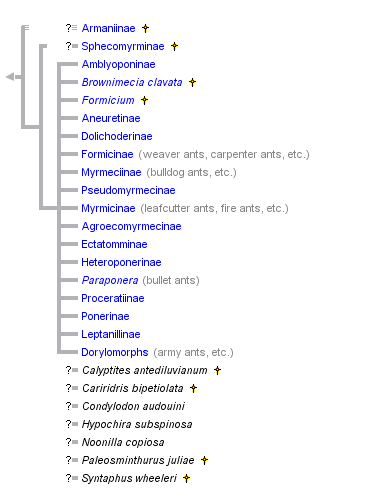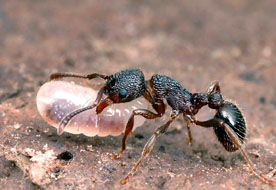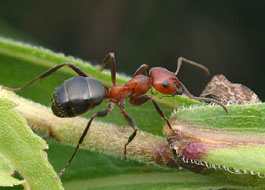Formicidae
Ants



This tree diagram shows the relationships between several groups of organisms.
The root of the current tree connects the organisms featured in this tree to their containing group and the rest of the Tree of Life. The basal branching point in the tree represents the ancestor of the other groups in the tree. This ancestor diversified over time into several descendent subgroups, which are represented as internal nodes and terminal taxa to the right.

You can click on the root to travel down the Tree of Life all the way to the root of all Life, and you can click on the names of descendent subgroups to travel up the Tree of Life all the way to individual species.
For more information on ToL tree formatting, please see Interpreting the Tree or Classification. To learn more about phylogenetic trees, please visit our Phylogenetic Biology pages.
close boxCharacteristics
Bolton (2003) gives the following list of general synapomorphies for the Formicidae (but note that several of these are not unique to ants and have evolved independently in other vespoids, and that several have been secondarily lost in certain ant lineages):- Eusocial, with perennial colonies
- Wingless worker caste
- Females with prognathous heads
- Infrabuccal sac between labium and hypopharynx
- Antennae elbowed (geniculate) between the funiculus and the elongated scape (scape short in the primitive subfamilies Armaniinae and Sphecomyrminae)
- Metapleural gland in females
- Abdominal segment II differentiated, forming a petiole (weakly differentiated in the primitive subfamily Armaniinae)
- Wings of alate queens shed after mating
- Mating performed in mass nuptial flights
- Forewings always lacking cross-veins 3rs-m and 2m-cu
References
Agosti, D., D. Grimaldi, and J. M. Carpenter. 1997. Oldest known ant fossils discovered. Nature 391: 447.
Baroni Urbani, C. 2000. Rediscovery of the Baltic amber ant genus Prionomyrmex (Hymenoptera, Formicidae) and its taxonomic consequences. Eclogae Geologicae Helvetiae 93: 471-480.
Baroni Urbani, C., B. Bolton and P. S. Ward. 1992. The internal phylogeny of ants (Hymenoptera: Formicidae). Systematic Entomology 17: 301-329.
Bolton, B. 1994. Identification Guide to the Ant Genera of the World. Cambridge, MA: Harvard University Press.
Bolton, B. 1995. A New General Catalogue of the Ants of the World. Cambridge, MA: Harvard University Press.
Bolton, B. 2003. Synopsis and Classification of Formicidae. 370 pp. Memoirs of the American Entomological Institute, Vol. 71. Gainesville, FL.
Brady, S. 2003. Evolution of the army ant syndrome: the origin and long-term evolutionary stasis of a complex of behavioral and reproductive adaptations. PNAS 100(11): 6575-6579.
Brown, W. L., Jr. 1954. Remarks on the internal phylogeny and subfamily classification of the family Formicidae. Insectes Sociaux 1:21-31.
Crozier, R. H., L. S. Jermiin, and M. Chiotis. 1997. Molecular evidence for a Jurassic origin of ants. Naturwissenschaften 84: 22-23.
Grimaldi, D. and D. Agosti. 2000. A formicine in New Jersey Cretaceous amber (Hymenoptera: Formicidae) and early evolution of the ants. PNAS 97: 13678-13683.
Grimaldi, D., D. Agosti, and J. M. Carpenter. 1997. New and rediscovered primitive ants (Hymenoptera: Formicidae) in Cretaceous amber from New Jersey, and their phylogenetic relationships. American Museum Novitates 3208: 1-43.
Hölldobler, B. and E. O. Wilson. 1990. The Ants. Cambridge, MA: Harvard University Press.
Rust, J. and N. M. Andersen. 1999. Giant ants from the Paleogene of Denmark with a discussion of the fossil history and early evolution of ants (Hymenoptera: Formicidae). Zoological Journal of the Linnean Society 125: 331-348.
Saux, C., B. L. Fisher, and G. S. Spicer. 2004. Dracula ant phylogeny as inferred by nuclear 28S rDNA sequences and implications for ant systematics (Hymenoptera: Formicidae: Amblyoponinae). Molecular Phylogenetics and Evolution 33: 457-468.
Schultz, T. R. 2000. In search of ant ancestors. PNAS 97(26): 14028-14029.
Shattuck, S. O. 1992. Higher classification of the ant subfamilies Aneuretinae, Dolichoderinae and Formicinae (Hymenoptera: Formicidae). Systematic Entomology 17: 199-206.
Ward, P. S. 1994. Adetomyrma, an enigmatic new ant genus from Madagascar (Hymenoptera: Formicidae), and its implications for ant phylogeny. Systematic Entomology 19: 159-175.
Ward, P. S., B. B. Bolton, S. O. Shattuck, and W. L. Brown, Jr. 1996. A bibliography of ant systematics. University of California Publications in Entomology 116:1-417.
Wheeler, G. C. & Wheeler, J. 1976. Ant larvae: review and synthesis. Memoirs of the Entomological Society of Washington 74: 1-108.
Wilson, E. O. 1987. The earliest known ants: an analysis of the Cretaceous species and an inference concerning their social organization. Paleobiology 13(1): 44-53.
Wilson, E. O., F. M. Carpenter, and W. L. Brown, Jr. 1967. The first Mesozoic ants. Science 157: 1038-1040.
Information on the Internet
- Antbase. American Museum of Natural History and Ohio State University.
- AntWeb. Tools for exploring the diversity and identification of ants. California Academy of Sciences.
- FORMIS: A Master Bibliography of Ant Literature
- Non-Native Ants. Names and geographic distribution data of the known non-native ant species of the world.
- Australian Ants Online. S. O. Shattuck & N. J. Barnett.
- Smithsonian Ant Database. Maintained by Ted Schultz.
- The Ants of North America. William and Emma Mackay. The University of Texas, El Paso.
- Ants of Costa Rica. John T. Longino, Evergreen State College.
- The Ants of West Africa. Brian Taylor.
- Japanese Ants Color Image Database
- Ant Studies in the Museu de Zoologia Universidade de São Paulo, Brazil
- Ants of Arizona
- myrmecos.net (fantastic ant photos by Alex Wild)
- Notes from Underground
- Ants of Cowling Arboretum and McKnight Prairie. A Carleton College student project.
- AntColony.org. Ant Colony Developers Association.
Title Illustrations

| Scientific Name | Myrmica sp. |
|---|---|
| Location | U.S.A. (Arizona) |
| Comments | Worker carrying brood |
| Sex | Female |
| Life Cycle Stage | Worker, larva |
| Copyright |
© 2003 Alex Wild

|
| Scientific Name | Formica exsectoides |
|---|---|
| Location | U.S.A. (New York) |
| Sex | Female |
| Life Cycle Stage | Worker |
| Copyright |
© 2003 Alex Wild

|
| Scientific Name | Eciton burchelli |
|---|---|
| Location | Paraguay |
| Sex | Female |
| Life Cycle Stage | Major worker |
| Copyright |
© 2003 Alex Wild

|
About This Page
Page copyright © 2002
 Page: Tree of Life
Formicidae. Ants.
The TEXT of this page is licensed under the
Creative Commons Attribution-NonCommercial License - Version 3.0. Note that images and other media
featured on this page are each governed by their own license, and they may or may not be available
for reuse. Click on an image or a media link to access the media data window, which provides the
relevant licensing information. For the general terms and conditions of ToL material reuse and
redistribution, please see the Tree of Life Copyright
Policies.
Page: Tree of Life
Formicidae. Ants.
The TEXT of this page is licensed under the
Creative Commons Attribution-NonCommercial License - Version 3.0. Note that images and other media
featured on this page are each governed by their own license, and they may or may not be available
for reuse. Click on an image or a media link to access the media data window, which provides the
relevant licensing information. For the general terms and conditions of ToL material reuse and
redistribution, please see the Tree of Life Copyright
Policies.
Citing this page:
Tree of Life Web Project. 2002. Formicidae. Ants. Version 01 January 2002 (temporary). http://tolweb.org/Formicidae/11247/2002.01.01 in The Tree of Life Web Project, http://tolweb.org/











 Go to quick links
Go to quick search
Go to navigation for this section of the ToL site
Go to detailed links for the ToL site
Go to quick links
Go to quick search
Go to navigation for this section of the ToL site
Go to detailed links for the ToL site